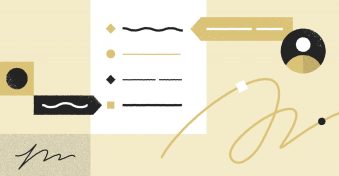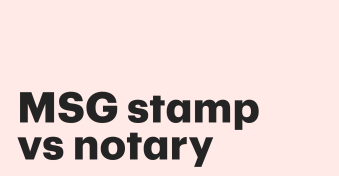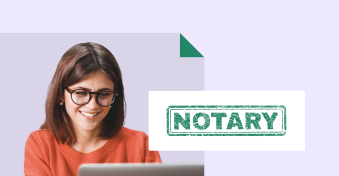In the notary world, jurats and acknowledgments are used for standard purposes. Of course, not everyone is part of the notary space and that prompts the need to learn a thing or two about jurats and acknowledgments. But whether you’re a notary expert or a layman, it is essential to understand the difference between the jurats and the acknowledgments.
In most cases, the difference between the jurats and the acknowledgments befuddles many people because of similar use cases and overlaps. At its core, both jurats and acknowledgments work as certificates. You can use these jurat notary stamps and acknowledgments to authenticate the identity of people who sign a relevant document.
Keeping that in mind, let’s expand the understanding of jurats and acknowledgments and their differences:
- What is a jurat?
- What is a jurat notary stamp?
- What is an acknowledgment
- Jurat vs. acknowledgment
- Remote Online Notarization of jurats and acknowledgments
- Why you should notarize documents online
1. What is a jurat?
A jurat is an oath-taker or someone who fulfills a duty under oath, such as a juror. A jurat can also be a declaration on an affidavit stating the date, place, and witness in which it was sworn.
Jurats are used to authenticate and verify the identification of an individual during the document signing. But the use cases of jurats extend beyond ID authentication of individuals.
In most cases, individuals use a jurat when they have to sign a specific document before taking an oath. The idea behind this function is to make sure the information within the document is legit and transparent.
2. What is a jurat notary stamp?
In layman’s terms, a jurat notary stamp is a tool that influences a specific person to be honest during the signing of a legal, financial, or other type of document. When it comes to jurats, notary public agents play an integral role and take care of the complex proceedings. Jurat discourages individuals signing a relevant document from committing direct perjury.
Ordinarily, if you sign a legal or banking document that has false or fabricated information, it would affirm intention and fall under the umbrella as a criminal offense in the court of law. It is the main reason the notary public makes sure that the specific document you sign contains correct information during the jurat.
Jurat use cases
It is crucial to understand that signing in the presence of a notary public translates into swearing on oath. And this honorable oath then serves as an official affirmation. For the most part, jurats are used mostly for legal proceedings like affidavits and depositions.
But whether it’s a deposition or affidavit, it requires the person in question to sign the document and attest that they stand by their statement with honesty. The fundamental objective of jurat or verification after affirmation or oath is to make sure the signer swears with complete sincerity and affirm the consents of the document with truthfulness to the official notary.
Essential requirements of a jurat
A jurat comes down to a few sequential steps:
- Some states may require you to identify the official signer.
- The signer has to show up during the proceedings in person and then sign the relevant document in the presence of the notary.
- You have to go through a written affirmation or spoken oath. At the same time, the signer should be able to respond. Remember that silent answers like nodding head are not acceptable.
Legally, loud and responsive affirmation is not required, but it is recommended for signers to raise their right hand and respond to affirm the oath with seriousness. Besides, you cannot implement a jurat if someone decides to take the oath in another person’s name. In fact, the original signer has to affirm and swear the oath in person and the presence of the notary.
3. What is an acknowledgment
Seeking out the services of a notary for acknowledgment is common practice. It refers to a process to identify the person signing a specific document. During the acknowledgment, the notary can certify and affirm that he has had the chance to meet the signer in person and can identify the signer.
A notary is essentially responsible to provide a guarantee for the signer to ensure the accuracy and transparency of the document. The identification process during acknowledgment also affirms that the signer is signing the document without external coercion and with his own free will.
Acknowledgment use cases
When it comes to acknowledgments, you can make the notary agent accountable for the authentication of the document’s content. In some states, the presence of the notary during the document signing is not required by the law. It means the signer can sign the document without an in-person notary.
But this use case depends on the fact that the person signing the document makes his or her presence known to the notary agent and attests the document for identification purpose. After attesting documents to ensure identification, the individual needs to sign in the notary journal.
Once this process is complete, the signer will be able to get an acknowledgment certificate with the official notary’s seal. When it comes to verifying the identification, the main goal of an acknowledgment serves in the interest of the signer. And that’s because the signer has to make an official declaration to the notary that he or she is willingly signing the document without any form of pressure or undue stress.
Essential requirements of an acknowledgment
The main requirements of an acknowledgment include:
- Notary has to identify the signer as per specific state rules.
- The signer should be able to appear before the notary in person.
- The signer needs to acknowledge or declare that he or she has signed the document for a specific purpose.
- The signer can sign the relevant document prior to an in-person meeting or physical and direct contact.
What else?
The signer should be able to maintain direct and consistent communication with the notary to prove the signing of the document is of his or her own accord. But unlike other states, Arizona allows the signer to use a translator to communicate with the official notary at the time of notarization.
4. Jurat vs. acknowledgment
Both jurats and acknowledgments are different types of notarizations and are used for different purposes. And whether it’s jurat or acknowledgment, both require their own certificate wording. It means the signer is not allowed to use a jurat notary stamp as an acknowledgment.
Similarly, the signer cannot use an acknowledgment as a jurat notary stamp. But in both cases, it is essential to use acceptable certificate wording required by your state. For instance, an acknowledgment stamp is worded like “acknowledged before me”.
On the other hand, the jurat notary stamp involves wording like “sworn, affirmed, or subscribed before me.” In most states, the use of acknowledgment is more common than jurats in the notarization of documents. Acknowledgments are used on official forms that are intended for public records.
Conversely, jurat is used to ensure the truthfulness, transparency, and honesty of the signer. It speaks to the consciousness of the signer and highlights criminal penalties in case of affirming false information. Remember that in most proceedings, the signature of the person signing the document serves as an oath and becomes a record of affirmation.
When it comes to the acknowledgment, you have to comply with standard state protocols and meet its criteria:
- The signer needs to appear in person to the notary and on a listed county and correct date.
- The notary needs to positively identify the signer.
- The signer needs to freely acknowledge the signing of the document.
When it comes to jurat, you have to meet the following state-designated criteria:
- The identity of the signer should be confirmed by the official notary.
- The signer has to appear in person at a specific date and a listed county in front of the notary.
- The notary should be able to administer an affirmation oath to the signer.
- The notary should review the signature affix in the document.
Fundamentally, acknowledgment plays a crucial role in identifying and verifying the signer. It serves as an official declaration to the notarial officer. Without this declaration, you cannot assume that the signer willingly decided to sign the relevant document.
The flexibility, however, works in favor of the signer. He can choose to sign the document in the notary’s presence or sign before appearing before the notary. It is critical to realize and recognize the subtle differences between the jurats and acknowledgments.
For instance, unlike a typical acknowledgment, the use of jurat is ideal to encourage or prompt an individual to sign the document of his own volition. In short, jurat represents truthfulness and honesty, whereas, acknowledgment reflects correct identification of the signer.
5. Remote Online Notarization of jurats and acknowledgments
Whether it’s standard notary stamps, acknowledgments, jurats, or signature witnessing, there is more than one way to notarize a document. In the digital era, many states have started to move to Remote Online Notarization. It is, after all, a technologically superior way to notarize documents.
On top of standard notarization, digital notarization is more secure, compatible, and fast than manual notarization. When it comes to Remote Online Notarization of jurats and acknowledgments, different states have different limitations and requirements. However, the process to perform notarization in both methods is simpler than you think.
Most of the misunderstanding stems from the technical terms and misuse of terms in the notary world. In fact, jurats and acknowledgments have many interchangeable terms that can apply to different situations. In other cases, you may have to seek out an expert opinion to understand the requirements of your state concerning jurats and acknowledgments.
Also, only state-approved notaries can perform Remote Online Notarization. In the context of jurats and acknowledgments, the notary and the signer are not bound by physical interaction and presence. Instead, both parties can use communication technology to make audio-video contact.
However, the notary should be present in the designated state before the signing of the document online. But the signer has the freedom to be present in any part of the world at the same time as the document signing.
Remote Online Notarization involves:
- Ability to access and review an electronic document
- Personal appearance through online communication technology by the notary and the signer
- The official digital notary stamp or notary seal
- Digital signatures of the notary and the signer
Follow basic requirements to perform remote notarizations:
- A notary who wants to perform Remote Online Notarization should first select a specific mode of communication program or system.
- A notary should complete the approval process based on official state-wide instructions through the communication platform.
- Pass the state examination to perform notarizations online.
- A notary can approve and finalize through a third-party tech provider.
It is important for notaries to be aware of different kinds of modern identification technologies. Fortunately, many notary technologies have been approved by various providers. As of now, the approved identification technologies include:
- Blockchain
- Identity proofing
- Public key certificate
- DKBA or Dynamic knowledge-based authentication
- Remote presentation and credential analysis
6. Why you should notarize documents online with PandaDoc Notary
At PandaDoc Notary, we offer the best Remote Online Notarization tools. Contact us to learn more information about the online notarization of documents and how different types of notary stamps come into play.
With our help, you will be able to digitally notarize any document for your business, fast. PandaDoc Notary champions Remote Online Notarization. It is the main reason we continue to help businesses understand complex processes and mechanics of the online notary world.
We offer a convenient and stress-free approach that makes the online notarization of documents effortless.
Conclusion
Remember that your notary can explain the basics of jurats and acknowledgments, but at the end, the signer gets to make the final decision. On top of legal proceedings and banking transactions, there are many instances that require notarization of documents with specific notarial wording.
At this stage, the signer should be aware of the difference between the jurat and acknowledgment stamps. On the surface, it may sound like a difficult task, but learning the similarities between the two will help you navigate the differences.
FAQs
When Do You Perform a Standard Jurat?
A jurat is performed when the signer of a notarized document takes an oath or affirmation, as administered by the notary carrying out jurat and notarization. When the jurat is performed, the signer must take the oath and sign the document in the presence of an actively commissioned notary public.
What Documents Require a Jurat?
A jurat is required for any document that requires that the individual providing a signature to be notarized must attest to the truthfulness of the information in the document. This can be required for a variety of different types of documents, including:
- Affidavits
- Sworn statements related to a court case or legal proceedings.
- Copies of vital records, such as birth and marriage certificates.
- Declarations
When to Use a Jurat Or Acknowledgement?
The main difference between jurats and acknowledgments is that jurats are required when a signed document contains sworn statements. On the other hand, Acknowledgments are used when a document requires verification that the signer is who they say they are. Typically, documents requiring acknowledgment will contain specific verbiage stipulating this, such as “acknowledged before me” or similar statements.
















